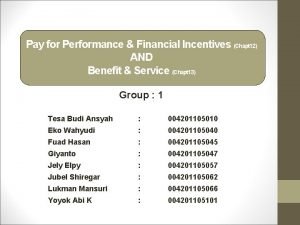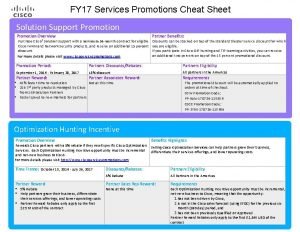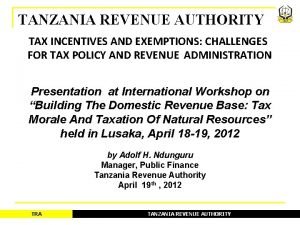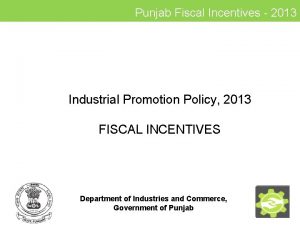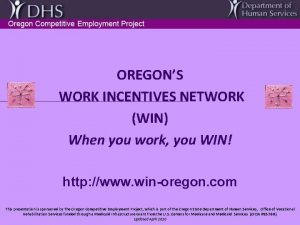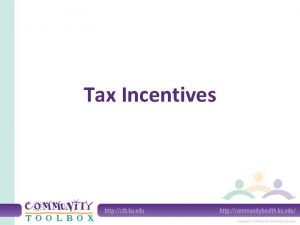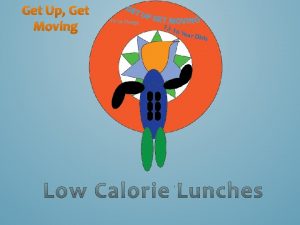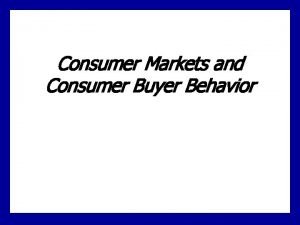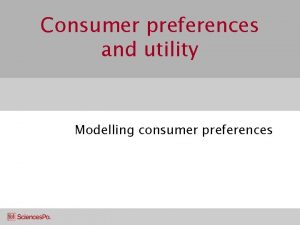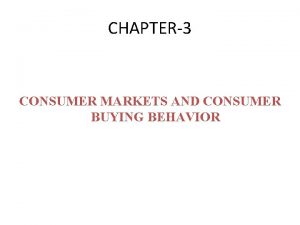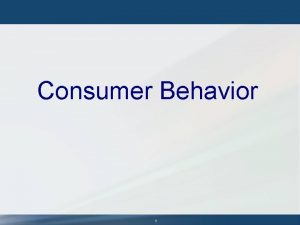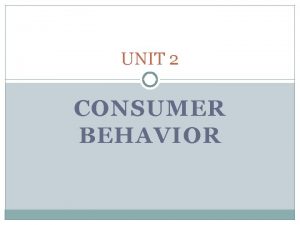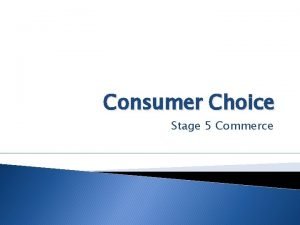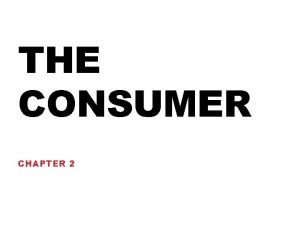Giving green to get green Incentives and consumer





















- Slides: 21

Giving green to get green? Incentives and consumer adoption of hybrid vehicle technology by Kelly Sims Gallagher, Erich Muehlegger Presented by Dindu Lama 19/02/2019

Introduction: Ø What is hybrid vehicle? ü The vehicles with hybrid electric engines which combine a gasoline engine and electric motor to improve fuel efficiency. ü This paper classifies hybrid vehicles as high fuel-economy hybrids if fuel economy is 50 % greater than non hybrid vehicles in the same class. ü And, others are low fuel – economy hybrids. ü Hybrid vehicles consume less gasoline and emit less pollution per mile than traditional non-hybrid vehicles.

Introduction: • Beginning in 2000, federal, state and local governments experimented with varieties of consumer incentives to stimulate hybrid vehicle adoption. • The incentives offered are income tax credits, sales tax waivers, single passenger access to carpool lanes, and waivers of emission testing, registration and parking fees. • In 2000, hybrid vehicle sales is less than 3000. • In 2006, the collective sales of hybrid vehicle is more than 230, 000.

State Incentives for hybrid vehicles, 2000 - 2006

State tax incentives:

Objective: • The main objective of this research is to find the effect of different incentives offered by state government on hybrid vehicle sales. • It also studies how adoption of hybrid vehicles varies with fuel prices.

Research Question: 1. Is consumer behavior affected by state incentive? 2. Do consumers behave differently to distinct types of tax incentives? 3. Do consumers respond to rising gasoline prices and, if so, how does the effect of rising gasoline prices compare to that of state incentives?

Contribution: • Previous papers find that incentives increases hybrid vehicle sales. • But previous studies focus on either federal or provincial incentives that vary by generosity but not by form. • This paper analyzes US state incentives that vary both by generosity and form. • It studies how generosity and form of incentives affect consumer adoption of hybrid vehicles.

Data: • This paper analyzes quarterly state level hybrid vehicle sales from first quarter of 2000 through fourth quarter of 2006. • The source of data on hybrid sales is JD Power and Associate’s Proprietary Power Information Network. • The data set is based on actual date of vehicle purchased and excludes fleet, corporate and government sales.

Data: • This study focuses only on state tax incentives and single occupancy access to HOV lanes because other incentives affects state level sales in small magnitude. • Data on incentives are collected by contacting officials from each jurisdiction. • Data on Annual Vehicles Miles traveled per capita (VMG) are from data published by Federal Highway Administration. • Data on gasoline price is from Energy Information Administration (EIA).

Methodology: •

Results: Hybrid incentives

Results: Hybrid incentives • Impact of tax incentive is positive and significant. • Offering tax incentive of $1000 increases hybrid vehicle sales by 5 %. • Increasing tax incentive by 1 % of vehicle MSRP increases hybrid vehicle sales by 1. 2 %. § Coefficient on HOV access is negative but not significant. § When estimated separately for each state, only Virginia has significant and positive impact of access to HOV lanes on hybrid vehicle sales. q 100 % increase in annual fuel saving increases hybrid vehicle sales by 13 %. q 10 % increase in gasoline price causes 8. 6 % increase in high fuel economy hybrid vehicle sales.

Results: Tax incentives by type

Results: Tax incentives by type • $1000 sales tax waiver rises hybrid vehicle sales by 45 %. • $1000 income tax credit rises hybrid vehicle sales by 3 %. • When alternative tax incentives are taken, v 1 % increase in sales tax waiver of MSRP increases hybrid vehicle sales by 8. 3 %. v 1 % increase in income tax credit of MSRP increases hybrid vehicle sales by 0. 6 %. • Using dummy variable if particular state offers income tax credit or sales tax waiver, ü Offering sales tax waiver is associated with 52 % in sales. ü Offering income tax waiver is associated with 15 % increase in sales. Consumers respond more to sales tax. But why?

Results: Why do consumers respond more to sales tax?

Results: Why do consumers respond more to sales tax? • If it is because of discounting, then effect of tax credit should be monotonically increasing over the course of year. • Analyzing coefficients seasonally, Ø Point estimates are highest in the second quarter and decline in each successive quarter. Ø But this pattern is not present in sales tax waiver. • Possible reasons are: ü Poor knowledge of income tax credit. ü Only 65 % of hybrid vehicle owner are aware of tax credit. ü Calculation of sales tax makes consumers overestimate sales tax waiver.

Sensitivity Tests:

Conclusion: • Generosity and type of tax incentives impact consumer behavior. • State sales tax waiver is less generous than state income tax credit but mean sales tax waiver ($1077) is associated with over three times increase in sales due to mean income tax credit ($2011). • Consumer’s response to single occupancy HOV access is not significant and not consistent. • There is positive and significant relation between gasoline price and hybrid vehicle adoption. • $100 increase in gasoline price increases hybrid vehicle sales by 13 %.

Conclusion: • Immediacy, transparency, and ease are important attributes while designing incentive. • The results show that “feebate” programs may be more effective at encouraging the purchase of high fuel-economy vehicles than waiver of registration or testing fees. • Rising gasoline price increases demand of high-fuel economy hybrid vehicles.

Further Research: • Impact of incentives on hybrid vehicle sales with interjurisdictional spillover. • Impact of state and federal incentives on hybrid vehicle sales. • Impact of state policies regarding incentives on hybrid vehicle adoption on national adoption.
 Get on get off
Get on get off Primary secondary tertiary food chain
Primary secondary tertiary food chain Refrain poetic device
Refrain poetic device Chapter 5 consumer markets and buyer behavior
Chapter 5 consumer markets and buyer behavior Types of buyer behavior
Types of buyer behavior Yellow light
Yellow light Is a greenfly a herbivore
Is a greenfly a herbivore Consumer diversity in consumer behaviour
Consumer diversity in consumer behaviour Consumer research in consumer behaviour
Consumer research in consumer behaviour Pay for performance adalah
Pay for performance adalah Mice
Mice Cisco promotions 2018
Cisco promotions 2018 Get up get moving quiz
Get up get moving quiz Get up get moving quiz
Get up get moving quiz Get up get moving
Get up get moving Example of sequence in pseudocode
Example of sequence in pseudocode Get focused get results
Get focused get results Get up get moving quiz
Get up get moving quiz Tax incentives in tanzania
Tax incentives in tanzania Sales promotion methods
Sales promotion methods Fiscal incentives for industrial promotion (revised)-2013
Fiscal incentives for industrial promotion (revised)-2013 Work incentives network oregon
Work incentives network oregon









